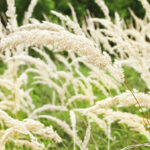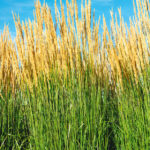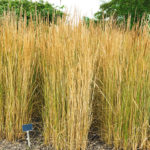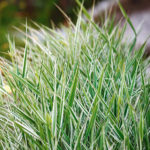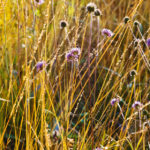How to use grasses to transform a garden or landscape
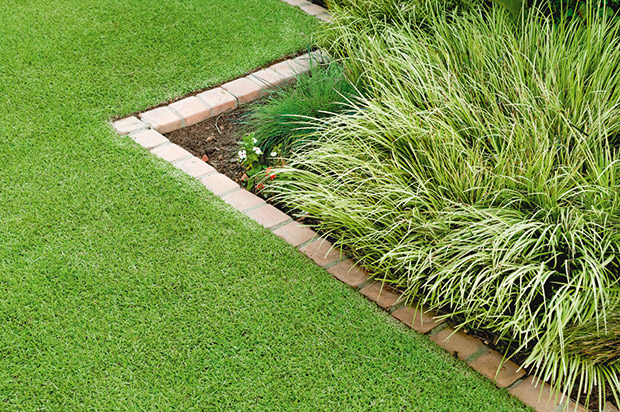
Some grasses, like Miscanthus sinensis are a colourful feature on their own.
Flowers are the bright and bold stars of a garden, but grasses are the frame that can make them sparkle.
Words: Jenny Somervell
This is the article I needed to read 30 years ago. Back then, I was growing perennial grasses in my nursery for sale, but I didn’t know how to use them in my own garden.
Their names conjured up alluring images: Japanese silver grass, blood grass, forest grass, wind grass, feather reed grass, purple moor grass.
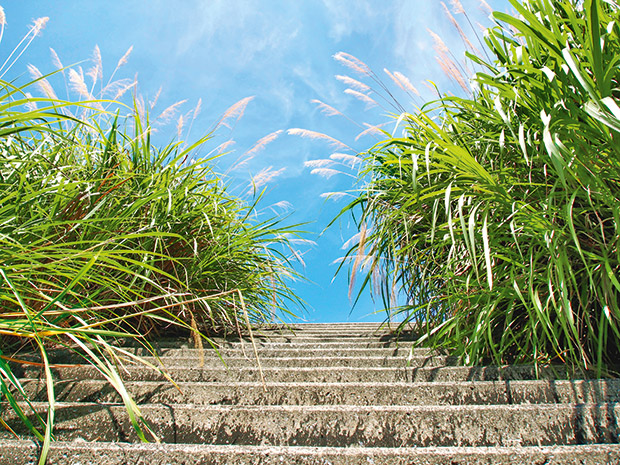
Miscanthus sinensis
Grasses provide architecture to a garden. They can define a space, giving it height, movement and colour, often through all four seasons. They have different weights and forms; some stiff and formal, others loose and casual.
10 REASONS TO USE GRASSES IN YOUR GARDEN
1. Dense, arching forms can be used as hedges and borders, to define and enclose areas.
2. Shorter grasses are useful as edgings to define the shape of a bed and bring a sense of order, without being too formal.
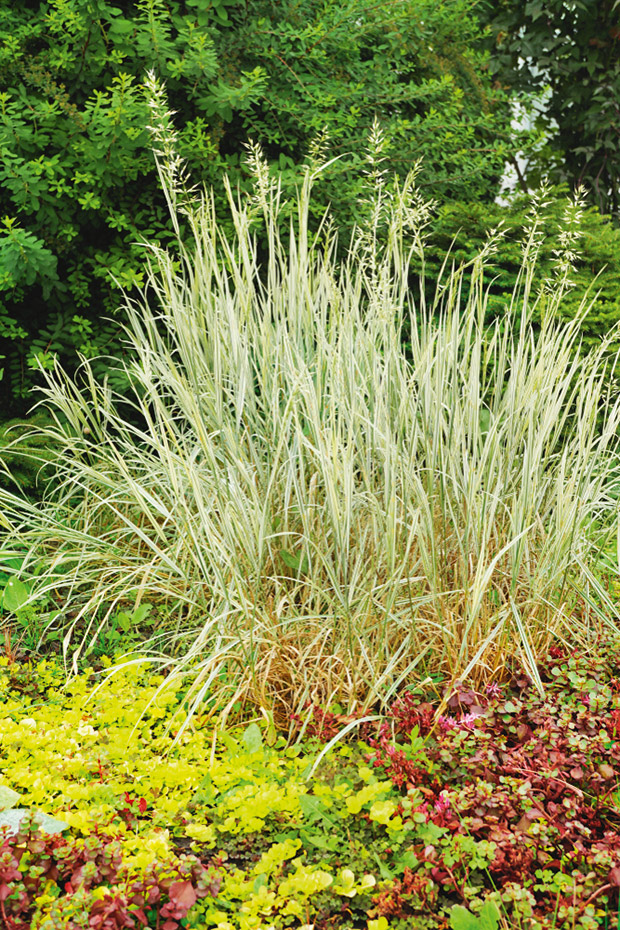
Blue oat grass, Helictotrichon sempervirens
3. Fountain-shaped forms and ‘wispy’ grasses like blue oat grass (pictured above) can create a soft edge.
4. Compact, tighter grasses like NZ native Carex sp. will give a tighter, more formal look.
5. Winter-dormant grasses don’t offer much colour in cool months, but they can add interest thanks to drying seedheads, or movement.
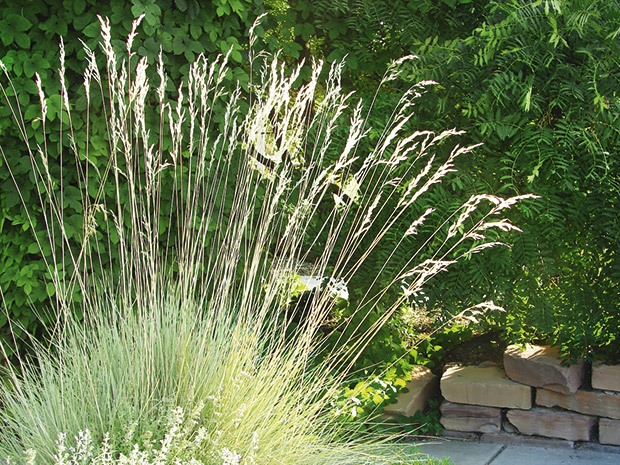
Blue Oat Grass,Helictotrichon sempervirens
6. A beautiful garden is always a mix of textures. You need fine textures among the bold or a garden can look ‘heavy’ and unappealing. For example, the large, brightly-coloured leaves and flowers of daisies and Eupatorium are softened and highlighted by the fine texture of grasses.
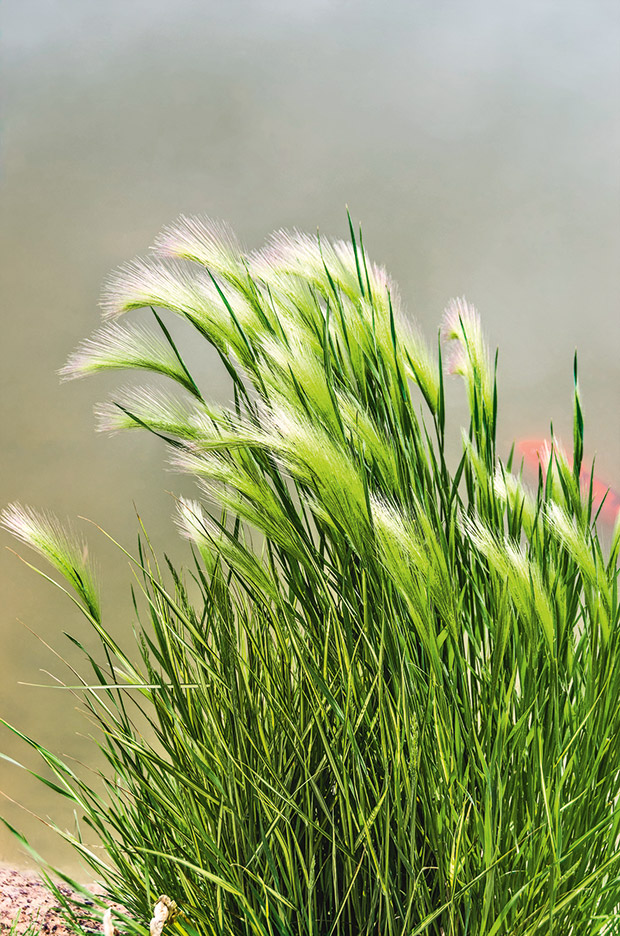
Feather reed grass.
7. Grasses help to separate colours which might clash, or help bright colours to stand out more.
8. A contrast in form draws the eye and provides interest. Vertical, fountain, cascading, or mounded grass forms can provide striking accents.
9. Grasses help during transition periods between seasons when perennial flowering plants wane. They can fill in bare spaces, and contribute late season colour through their flowers, foliage or both.
10. Grasses bring movement to a landscape, especially when planted in large groups in windy sites.
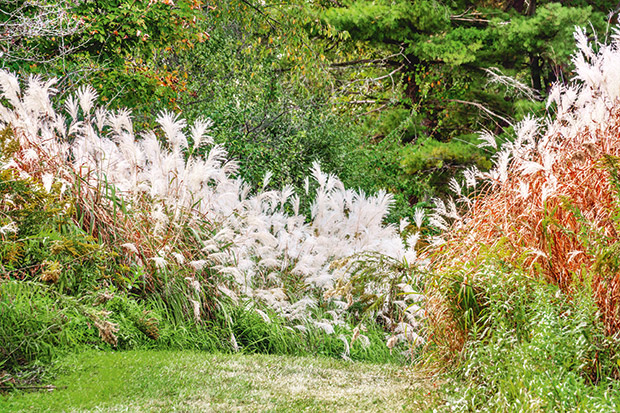
Grass adds height and movement to a landscape.
Jenny’s favourite grasses
TALL AND FEATHERY
Feather reed grasses
Calamagrostis x acutiflora, C brachytricha
These have a distinct, upright form, and rich, glossy green foliage. The loose feathery flower plumes in late summer tend to have a light purplish-pink blush. The flowers age to tan as they dry and stay intact into winter.
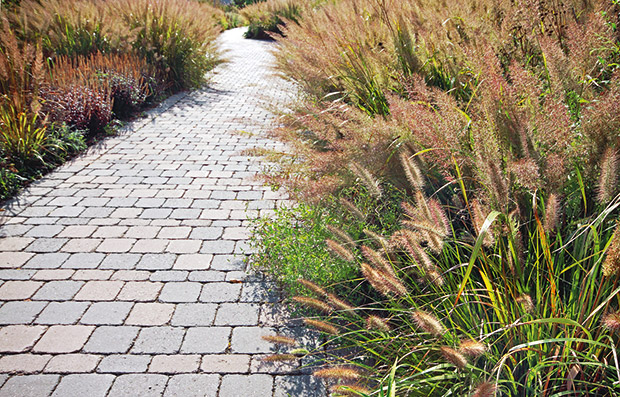
Feather reed grass, Calamagrostis brachytricha
Calamagrostis plants are clump-forming and vigorous, but they will not take over a border. They prefer average to moist, well-drained soil in full sun. They will tolerate dry soil.
How to use it: Calamagrostis is a wonderful vertical contrast among tall or short, mounded perennial plants. It works well with a range of flower and foliage colours. You can use it to divide or enclose an area, for example a deck or border, without giving it a ‘heavy’ look.
- Soft, feathery heads ‘nod’ and wave, but don’t look ‘heavy’.
- Feather reed grass in clumps.
- After drying off in winter they create tall, dry stands.
Jenny’s recommendations:
C x acutiflora Karl Foester: (Height: 120-180cm) Upright, with vertical flower heads in late summer, best at the back of a border as only the top half is ornamental. It is sterile, so won’t self-seed and has to be grown by division.
C x acutiflora Overdam: (Height: 75-90cm) The variegated leaves create a grey-green effect, lovely with white or yellow-flowering companions.
C brachytricha: (Height: 90-120cm, up to 150cm in flower) Very drought-tolerant.
FOUNTAIN EFFECT
Japanese silver grass
Miscanthus sinensis
This is one of the finest ornamental grasses, forming a clump of attractive, arching, mid-green foliage. In late summer, but more often early-to-late autumn, the flower heads are elegant plumes of white, silver or buff, sometimes pink-tinged, standing well above the foliage.
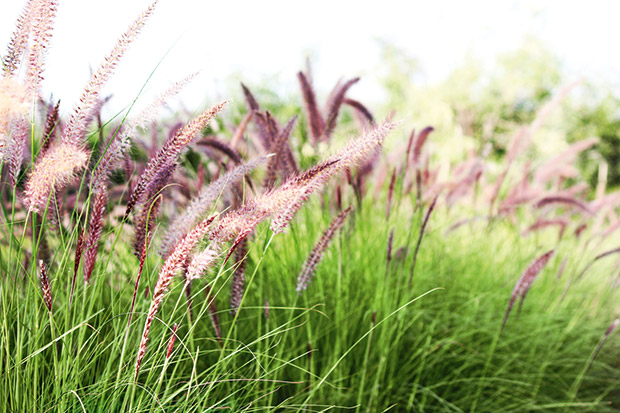
The flower heads of Miscanthus sinensis can have a pink tinge.
Miscanthus likes a moist, but free-draining soil. Most varieties like full sun. Cut back to about 20cm each spring. Propagate by division in spring or early summer.
How to use: The green-leaved varieties contrast with brightly-coloured or intricately-patterned flowers, such as lilies, or with other white or variegated Miscanthus.
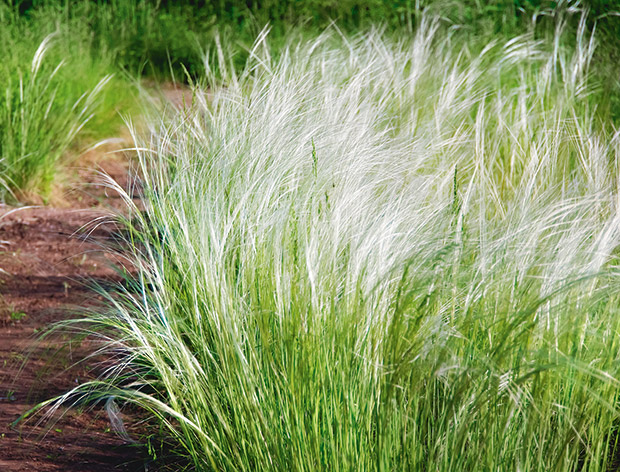
The flower heads of Miscanthus sinensis can also be more silver-white.
Jenny’s recommendations:
M sinensis Morning Light: Its white-edged leaves look fabulous with white flowers.
M sinensis Zebrinus: The yellow-banded leaves of Zebrinus (see below) go well with bright yellow flowers like Solidago.
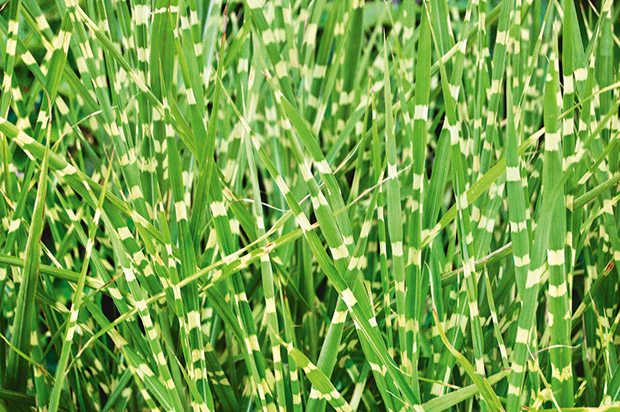
Wind grass
Anemanthele lessoniana syn. Stipa arundinacea
This has a loose, wavy fountain-like habit and lovely colour effects. Elegant, arching, dark green, thread-like leaves are followed in summer by sprays of rosy flowers.
These hang down, almost touching the ground. In autumn-winter, the leaves develop irregular streaks of copper, orange and bronze. Anemanthele is fast-growing, usually evergreen, versatile and easy to grow. It’s suitable for mass planting, erosion control on dry hillsides, and gravel beds.
It likes a medium-to-light, well-drained soil in sun or light shade, but unlike many grasses, it will tolerate clay. Comb back dead leaves and cut back every two years for a fresh look. Easily propagated by seed (it will self-seed if happy) or division.
How to use: Wind grass is a great choice for informal plantings with flowering perennials, either as an accent or a backdrop.
3. MISTY PURPLE EFFECT
Purple moor grass
Molinia caerulea
This elegant, perennial grass has very soft, lush leaves and airy flower heads, which add texture and movement to a perennial garden. The tiny, greenish flowers are usually tinged purple, hence the name.
- Moor grass in variegated form.
- And the more traditional type in flower.
The leaf form is upright or vase-shaped. The airy flowers are borne on tall, arching stems well above the leaves, giving them a wonderful see-through effect. Molinia is native to bogs, and moist mountainous places. It doesn’t like to be too dry, but will tolerate low-fertility soils.
How to use: In autumn the leaves turn a rich yellow. This grass is gorgeous when backlit by the rising or setting sun.
4. EDGING
Carex
Carex sp.
NZ native carex is technically a sedge rather than a grass, but is widely used in landscaping for its grass-like effects. Plants are evergreen, hardy, neat, and versatile. Many perform well in shade. Dwarf forms make useful, formal to semi-formal edging plants.
If carex becomes untidy, cut back to within 5cm of the ground and they will regenerate with new vigour.
How to use: The low, compact form of evergreen carex makes them a great edge or border to garden beds.
Jenny’s recommendation:
Carex buchani: This variety has striking, copper-bronze foliage. While young, it has an erect habit, but gradually it forms a vase-like shape as the leaves arch over, curling at the tips. It mixes well in a more informal bed with bulbs and perennials, and in permanent landscapes with shrubs. It does best in sun or light shade in a moist, well-drained soil. It dislikes prolonged dry conditions.
5. WOODLAND COMPANION
Hakone grass
Hakonechloa
This elegant grass is the perfect partner for woodland perennials. As autumn approaches, variegated cultivars develop pink or reddish-purple colours. Many green-leaved cultivars turn orangey or red. Hakonechloa likes part-shade in average-to-moist, well-drained soil. Plants spread slowly by rhizomes, and can be divided when dormant.
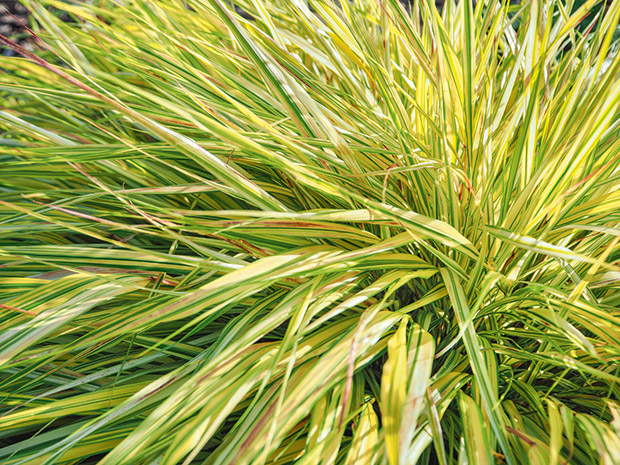
How to use: Perfect for hostas and other woodland perennials. The slender, arching leaves create a flowing effect, lovely around larger mounded plants, or upright perennials. Solid yellow or striped leaved varieties look fabulous contrasted with dark-leaved purple heuchera, or blue-leaved hostas.
6 GREAT GRASSES AT A GLANCE
1. Calamagrostis x acutifolia
Colour: Green to variegated
Height: 1-1.5m
Special effects: Strong vertical line, back of border
Perennial companions: Purple Agastache, Salvias, Liatris, Coreopsis, Heliopsis, Echinacea, Eryngium, Echinops, Rudbeckia, upright Sedums
2. Carex sp.
Colour: Green to bronze foliage
Height: 30-80cm
Special effects: Soften and define edges, support or accent plant
Perennial companions: Geranium, Helleborus, Heuchera, Phlox, Sedum, Stachys, Astilbe. Hosta, Salvia
3. Miscanthus
Colour: Green to variegated foliage, flowers: white, silver or buff, often pink-tinged
Height: 75cm-1.5m
Special effects: Fountain effect, tall, dense hedge, Foil for flowers
Perennial companions: Aster, Eupatorium, Echinacea, Boltonia asteroides, Rudbeckia, Helianthus, Japanese anemones, Chyrsanthemum, Aconitum
4. Molinia
Colour: Green to variegated, yellow- golden-orange in autumn, flowers: tinged bronze to purple to tan as they mature
Height: In leaf – 30-90cm, in flower 90cm-2.4m
Special effects: Texture and contrast Ethereal, airy flowers
Perennial companions: Agastache, Monarda, Lillium, Echinacea, Helenium, Japanese Anemone, Heuchera, Astilbe, Aster novae-angliae, Hemerocallis
5. Hakonechloa
Colour: Green to gold foliage in summer, pink to red and orange in autumn
Height: 30-60cm
Special effects: Arching, flowing effect, colour contrast in shade
Perennial companions: Hosta, Ajuga, Ligularias, Helleborus, Geranium, Anemone, Woodland Phlox, Astilbe, Alchemilla
6. Anemanthele lessoniana
Colour: Dark green to copper-orange foliage and bronze in autumn-winter, flowers: hanging rosy sprays
Height: 90cm x 1m wide
Special effects: Fountain effect, accent or backdrop
Perennial companions: Many flowering perennials eg Echinacea, Helenium, Achillea, Agave, Sedum, Kniphofia, Hemerocallis, Rudbeckia
Love this story? Subscribe now!
 This article first appeared in NZ Lifestyle Block Magazine.
This article first appeared in NZ Lifestyle Block Magazine.
